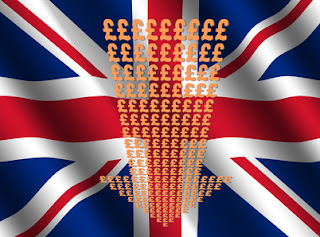Sterling has been pounded by the YouGov poll that showed that those
favoring Scottish independence have gained a slim majority for the first
time. It does not matter than other polls have yet to confirm
it. A "yes" vote was widely seen as a high impact event, though
calling it a Black Swan probably does not do justice to the long planned
event. The major parties in the UK are expected to announce a new
devolution agreement for Scotland to entice the rejection of
independence.
Sterling gapped sharply lower in Asia. It had finished last week just
above $1.6325, after having fallen to almost $1.6280 before the disappointing
US job growth. It opened near $1.6190 in Asia... Gaps are rare
in the 24-hour a day foreign exchange market, and we find they often
significant. From a technical perspective, the gap may be of greater
significance as it will appear on the weekly bar charts as well.
Sterling has yet to stabilize and made new lows in the European morning.
The $1.6080 area corresponds with the 100-week moving average. |The $1.60
area houses the 200-week moving average and the 50% retracement of sterling's
rally since July 2012.
British asset markets have not shown the same dramatic reaction as
sterling. The FTSE is under performing, but the 0.65% decline is not
significant, and most European bourses are lower in any event. The
10-year gilt yield is off a little more than 1 bp. Short-term UK
interest rates as reflected in the short-sterling futures strip have fallen
considerably, with the yield on the March 2015 contract falling nearly 7 bp to
78 bp. This is the lowest yield in a year.
The other major currencies are little changed. The euro remains
in the trough seen in the reaction to the ECB's initiatives announced last
week. It has been unable to find much solace in the softer US employment
data. It has been confined essentially to a 15 tick range on either side
of $1.2945. While the Sentix survey was disappointing, news of
Germany's swelling trade surplus helps ease fears that Europe's largest economy
was recession-bound after contracting in Q2.
Exports rose 4.7% after a 0.9% increase in June. Imports
slipped 1.8% after a 4.5% rise in June. This produced a 23.4 bln euro
trade surplus. The consensus was for 16.8 bln euro surplus after 16.6 bln
in June. This follows the stronger than expected industrial production
figures reported at the end of last week.
China, Hong Kong, Korea and Taiwan markets are on holiday today.
China reported a larger than expected trade surplus of $49.8 bln in August
after $47.3 bln in July. Exports rose 9.4% on a year-over-year
basis. The consensus was for 9.0% after 14.5% in July. The bigger
surprise was with imports. They fell 2.4% year-over-year. The
market had expected a 3.0% increase after a 1.6% decline in
July. It is the first back-to-back decline in imports since
May-June 2013.
Japan revised its Q2 GDP to show a biggest contraction (7.1% vs
6.8%). This was a function of much weaker capital expenditures (-5.1%
quarter-over-quarter rather than -2.5% as initially reported). This was
only blunted by a larger than expected build of inventories. The net
effect was a collapse of private demand (-19.2% quarter-over-quarter).
Separately, Japan reported a somewhat smaller than expected July current
account surplus of JPY416.7 bln. The consensus had expected a JPY444..2
bln surplus.
The dollar continues to straddle the JPY105 area, though it remains
within the pre-weekend trading range today. The driving force
is not an increase in US rates, which we had anticipated being the
catalyst. The US 10-year yield is at 2.43%. Rather, it seems that
capital outflows from Japan have stepped up and speculators have continued to
amass a large short position. The divergence between the US and Japan's
monetary stance and economic performance are palpable.
The North American calendar is light today with US consumer credit due
out late in the session. The disappointing jobs data does not appear
to be impacting expectations for next week's FOMC meeting, where the exit from
the QE and adjustments to the forward guidance are the main talking
points. Canada also reported soft jobs data, which are harder to shrug
off. Today it reports building permits, which should correct lower after
the outsized 13.5% jump in June. A US dollar gain above CAD1.0920 may
signal a re-test on CAD1.10.
Pounded
 Reviewed by Marc Chandler
on
September 08, 2014
Rating:
Reviewed by Marc Chandler
on
September 08, 2014
Rating:
 Reviewed by Marc Chandler
on
September 08, 2014
Rating:
Reviewed by Marc Chandler
on
September 08, 2014
Rating:






